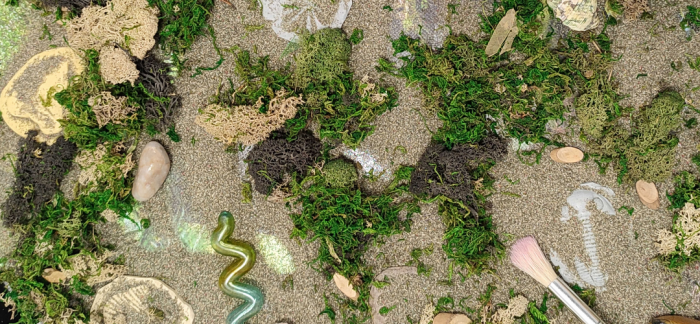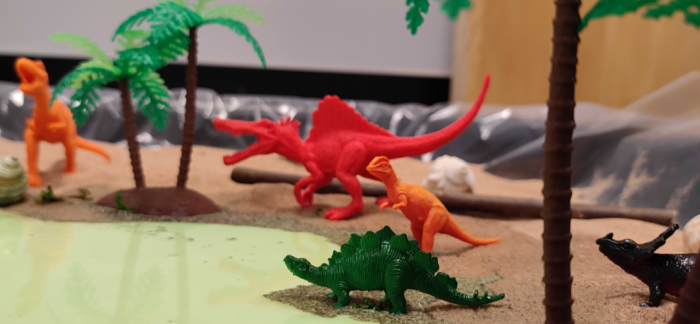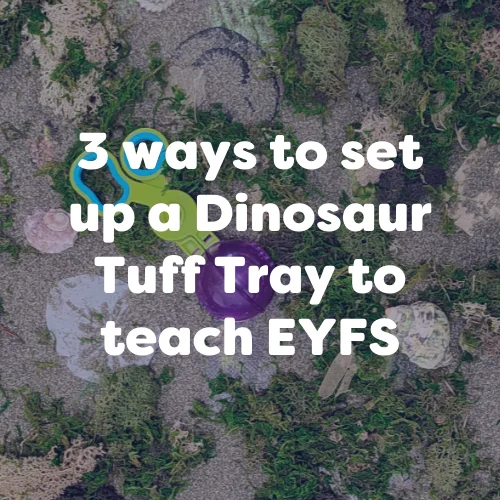Tuff trays are a great tool for teaching toddlers about the basics of life. The tuff tray helps children learn through play. It can be used in an infinite number of ways to teach children. From colours, shapes, numbers, and letters, to manners and more! Setting up a dinosaur tuff tray is a great way of teaching children about ancient creatures, fossils, and archaeology.
Dinosaurs are a favourite subject of children and adults alike. From the Jurassic period to the Cretaceous period, these creatures have always fascinated people with their size and power.
Here are 3 EYFS dinosaur tuff tray ideas for you to try!
1. Match the Dinosaur to its shape
Matching shapes to outlines is a great game for children. It helps them develop their matching skills and hand-eye coordination. The most common shapes for this game are circles and squares, but why not try it with dinosaurs? A great way to create outlines is to use dinosaur templates and stencils.
Print out our free downloadable dinosaur colouring in sheets and cut around them. On a whiteboard, draw around the cut out shapes and let children match the dinosaur to its shape. Alternatively use dinosaur figures and sort by colour, shape or size.
Supplement the game with books about dinosaurs, such as Yellow Door Dinosaur Footprints to make the dinosaur tuff tray extra special.

2. Dig for fossils
Digging for fossils is a fun, educational activity. Fossils are the remains of ancient plants and animals that have been preserved in rock or other materials. You can find them on land or at the bottom of water bodies such as lakes, rivers, and oceans.
In your Tuff Tray, add a Jurassic Tuff Tray mat for a background. Then place your fossils like dinosaur skulls and bones all around the tray, before finally covering them with sand and natural loose parts so that they are hidden well.
Supply children with brushes, scoops, and magnifying glasses to search for fossils in the sand. How many can they find?

3. Sensory oobleck dinosaur swamp
Sensory play provides children with a natural way to explore and process new information. Research has shown that sensory play builds nerve connections in the brain which then helps children to complete more and more complex tasks. It is fantastic for developing language, problem-solving skills, fine and gross motor skills all whilst playing! To learn more about the importance of sensory play then head to our other blog post: The importance of sensory play.
Creating an oobleck dinosaur swamp is a great way to get the little ones exploring their senses. Read on to discover how to create this small world setup and activity suggestions!
How to create your own swamp…
You will need:
- Cornflour
- Water
- Food colouring
- A tuff tray or sand play tray
- Dinosaurs
- Various utensils like scoopers, spoons, cups etc
Simply mix 2 parts cornflour with 1 part water until you get the perfect gloopy consistency and add a food colouring of your choice. The set-up itself is a fun activity for children; by asking them to add the water, they can experiment with consistencies and feel the difference with their hands.
Finally, add your dinosaurs and let them play! You could easily extend this activity by encouraging children to add other items to the swamp and discuss their choices with them. Items could be gathered from walks outdoors or from around the house.
Try and encourage discussions with your little ones by asking questions like: “does the swamp feel soft or hard?” “Is it cold or warm?” “What can we find to add to the swamp?” “Can you create a story with the dinosaurs?”

Alternatives…
One of the pros of creating a swamp is that there is no such thing as a perfect setup!
- Don’t have cornflour? Try making jelly, using Gelli baff, play foam, squirty cream or soap flakes
- Don’t have dinosaurs? Try using any small world figures that your child is interested in – it could be minibeasts, fairies, or even pirates!
- Why not try adding flavouring or scents to the cornflour mixture for children to explore their sense of smell?




